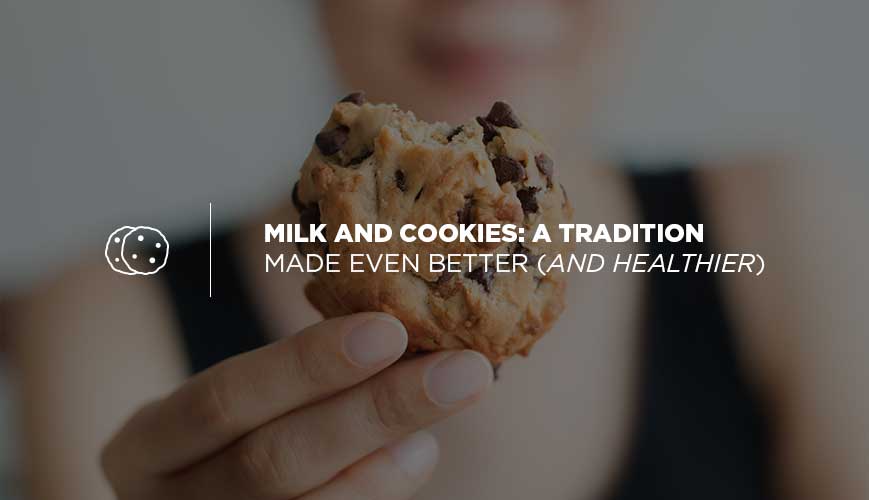Milk and Cookies: A Tradition Made Even Better (and Healthier)
By Sara Butler

It’s November and you know what that means -- it’s time for baked goods. Pies and cookies abound, and the more cookies you eat, the more you want to wash them down with a cool glass of milk. These are traditions people look forward to all year long.
At The Joint Chiropractic, we’re all for enjoying the holiday season but we also think that injecting some healthy habits into it is a good idea. Life is all about balance, after all. With that in mind, we’ve created this list of ways you can make your seasonal treats a little healthier, including those cookies and milk you leave out for Santa. He may be jolly, but we all know that extra weight he’s packing isn’t very healthy.
It’s Beginning to Look a Lot Like Cookies Season!
Who doesn’t love cookies? From little kids to older adults, they’re a perennial favorite year-round, especially during the holidays. But as you’re likely aware, cookies aren’t the healthiest of treats. They’re full of sugar and fat, so you have to be careful about how many cookies you indulge in. Or do you?
There are some ways you can make your recipes a little healthier for the holidays and beyond -- and not in a bran muffin kind of way, either. These suggestions make the cookies better for you and also still maintain their status as a tasty indulgence. You can try to health up your next baking day by:
- Going vegan - What’s nice about vegan cookies is that they’re free from butter and other animal products, but you can go beyond simply leaving out the butter. Try using dark chocolate in your cookies or maple syrup to help cut down on the sugar and add a punch of protein with some nut butter or protein powder. Best of all, vegan cookies have no eggs, so you can eat the batter right from the bowl safely! That’s a win!
- Using healthier flour - Coconut or almond flour instead of refined, enriched flour is a good idea. Whole wheat flour also can help to tone down the impact on your blood sugar that using highly processed white flour can have. If you want to experiment, you can always try going half and half -- use half alternative flour and half traditional flour to see what happens. Baking is a science experiment, after all!
- Using applesauce - If you have someone in your circle with high blood pressure, heart issues, allergies, or high cholesterol, then think about switching out the eggs for applesauce. Applesauce adds in the moisture that cookies need without sacrificing flavor. Great for those vegan bakes, too!
- Trying sugar alternatives - Cookies need to have sugar, it’s a main ingredient. But you aren’t limited to white sugar. You can find alternatives to white sugar at the store that you may want to give a try, such as coconut sugar. It’s still sweet but far less refined than traditional white sugar.
- Going nuts - Nuts add crunch as well as a healthy dose of fats to whatever you bake. And don’t be afraid to be creative when it comes to nuts. You can go conventional with peanuts, almonds, or walnuts, or you can get imaginative with pumpkin seeds, Brazil nuts, and even sunflower seeds.
Don’t Forget the Milk!
What would some cookies be without milk to wash them down? These days, you’re not simply limited to cow’s milk, either. There are a bunch of different milks on the market to choose from. The question is: How healthy are milk alternatives?
- Cow’s milk - Going with whole cow’s milk will provide 8 grams of protein per serving with about 4 grams of fat.
- Almond milk - If you opt for almond milk, then you’ll get about 1 gram of protein and about 4 grams of fat per serving.
- Soy milk - With a whopping 7 grams of protein, soy milk is a great replacement for cow’s milk. One serving will provide about the same amount of fat too, with 3.5 grams.
- Coconut milk - Coconut milk has about 5 grams of protein per cup with about 4 grams of fat.
- Oat milk - In a one cup serving, you’re looking at about 4 grams of protein and 2.5 grams of fat.
Now you have the information you need to make your milk and cookies a little healthier this year. Don’t forget to dunk!
The information, including but not limited to, text, graphics, images and other material contained on this page are for informational purposes only. The purpose of this post is to promote broad consumer understanding and knowledge of various health topics, including but not limited to the benefits of chiropractic care, exercise and nutrition. It is not intended to provide or be a substitute for professional medical advice, diagnosis or treatment. Always seek the advice of your chiropractor, physician or other qualified health care provider with any questions you may have regarding a medical condition or treatment and before undertaking a new health care regimen, and never disregard professional medical advice or delay in seeking it because of something you have read on this page.